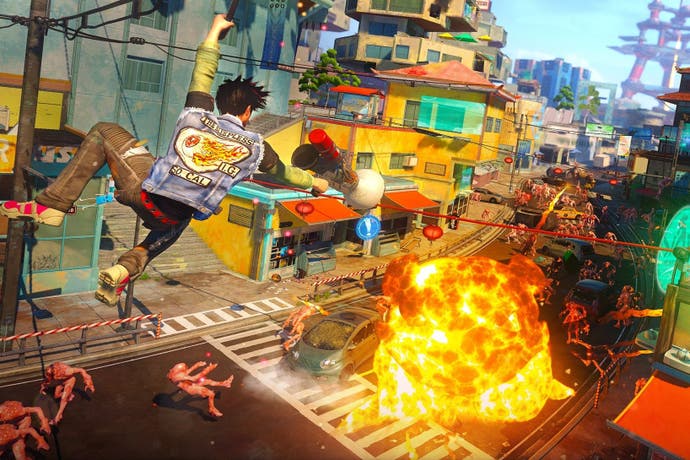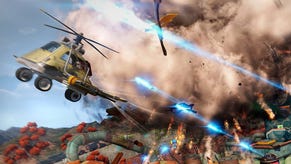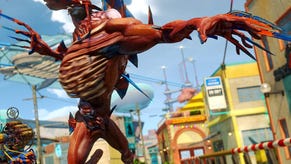Sunset Overdrive's respawns: should more games rethink the little things?
That Bill & Ted homage is a good start.
You can die a million different deaths in games, but you generally have much less control over how you're born. I'm not referring to that weird bit in Assassin's Creed 2 where you're suddenly a tiny baby learning to kick your arms and legs about, but rather those everyday births most video games offer - the simple, frequently unglamorous business of arriving on the screen at the start of a level, or after a nasty accident involving knives, guns, or teleporting cyber ninjas.
I didn't notice quite how limited your spawning options generally are until I saw a video for Insomniac's new game Sunset Overdrive. Up to the moment I saw it in action, I'll admit I'd written the project off as just another release from a developer I've always found a little underwhelming. In the first screenshots, with their garish colours and bright blue skies, it all looked a touch self-conscious, too. It had the flat mania of organised hilarity to it.
But then I saw it in motion. More importantly, I saw the respawns in motion. Just watch them for yourself, in fact - they're right at the end of this video.
Sure, when it comes to the really big stuff, Sunset Overdrive's looking like it's got things covered. The rail-grinding brings back all the right memories of Jet Set Radio, and the weaponry suggests that Insomniac's as comfortable as ever with the outlandish and the unlikely and the over-powered. What's really stuck with me, though, is the fact that when you die, you might re-enter the level in a dozen different ways - crunching down into the surface of the planet in a rocket ship, say, or warping in as part of a weird homage to Portal or Bill & Ted - the twin gods, I hope you'll agree, of everything that's best in contemporary culture.
Insomniac calls it Next-Gen Respawning, which suggests that even developers can have a little tongue-in-cheek fun with the ludicrous claims that often accompany next-gen propositions. That said, I saw it and thought: why don't more games do stuff like this? And then, of course, I realised money's probably an issue, as is appropriateness. That last one's particularly limiting. If I'm Batman in Arkham Knight, I probably shouldn't pop out of a coffin doing the Michael Jackson Thriller dance, just as I shouldn't be thrown from the side doors of a van if I'm about to start hopping about Renaissance Europe in Assassin's Creed.
There is a deeper issue, though. Why don't more developers rethink the little - often even cosmetic - assumptions that make up the texture of games? Assumptions like there being only one or two ways to arrive in a stage after a screw-up. What happens if you keep on questioning the little things, too, wondering how you can bring new life to a level breakdown screen, say, or the animation for a collectable?
You don't get massive changes, I guess, but you add to the warp and weft of a game in exciting peripheral ways instead. Sunset Overdrive's really starting to look like serious fun now, and it's partly because of this creativity, this energy, that seems to be seeping into unusual places.
I'm all for designers who are ready to tackle the big issues in games, then, and I'm glad to see we have a lot of these designers on the scene at the moment. But it's also such a pleasure to see those little elements get some TLC as well. After all, the things we take for granted are often the things that can really surprise us.













-3-31-23-screenshot.png?width=291&height=164&fit=crop&quality=80&format=jpg&auto=webp)




